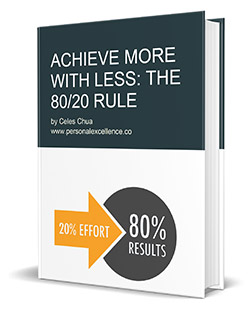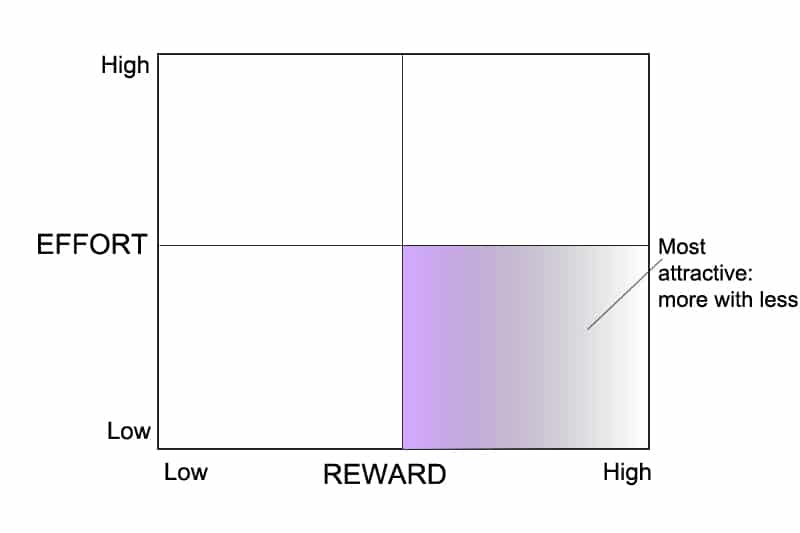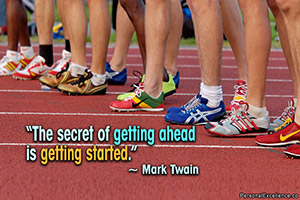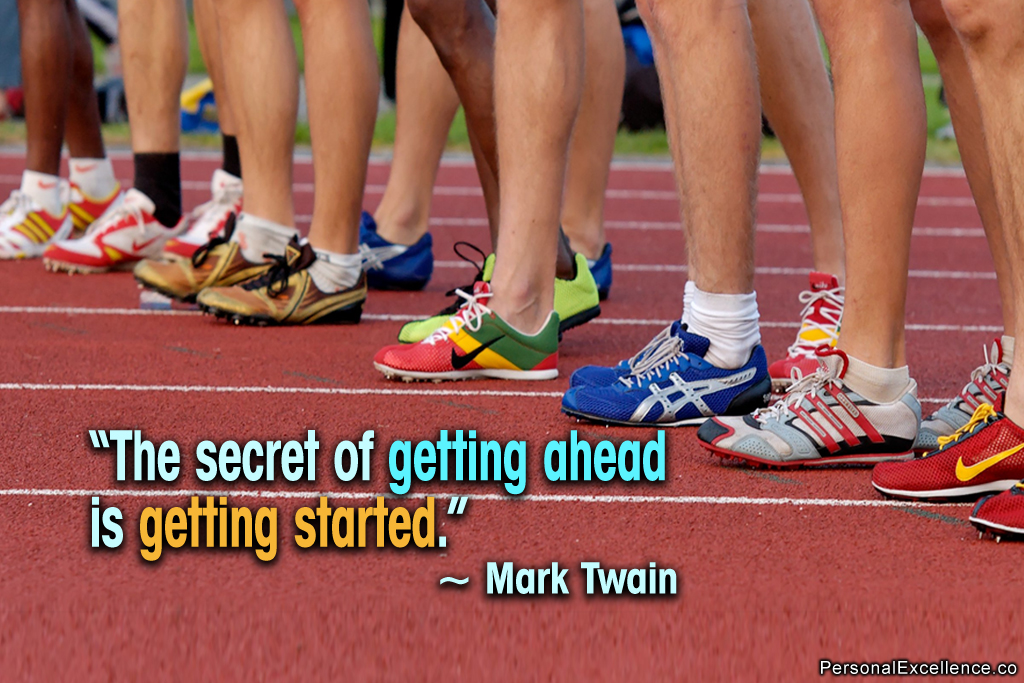
This is the last part of a 3-part series on the 80/20 principle and how to achieve more with less in life with it.
- Part 1: The 80/20 Principle: How To Achieve More With Less In Life
- Part 2: Why You Should Not Resist The 80/20 Principle
- Part 3: Apply 80/20 to Your Life Now in 3 Simple Steps

(Image: Personal Excellence)
There are three simple steps to apply the 80/20 to your life, as outlined in Living the 80/20 Way.
Step 1: Identify your 80/20 goals
Start off by identifying your 80/20 goals. They are your 20% goals that will give you 80% of total happiness when achieved, where 100% is the collective happiness from achieving all your goals. (Koch referred to them as the 80/20 destination, but I call them the 80/20 goals.)
What are the 20% goals you truly, truly want? What are the 20% goals that really matter to you? These are the goals you should focus disproportionately on. Keep to 2-3 goals. They should be in line with your life purpose.
The idea is not to overwhelm yourself with 50 goals, because every goal needs time and effort to achieve it. While you can still have a big list of goals (such as for your bucket list), being clear about your 80/20 goals helps you focus on your big rocks in life.
Step 2: Identify your 80/20 path
Every goal typically has four possible paths we can take to achieve it:
- Low Effort, Low Reward
- High Effort, Low Reward
- High Effort, High Reward
- Low Effort, High Reward
Now if you are to choose, which path should you take?
If you answered #4: Low Effort, High Reward, you are right! This is the 80/20 path, the simplest path to achieve maximum results. (Koch referred to this as the 80/20 route.)

More with Less Chart (From: Living the 80/20 Way)
Say you are a student and you want to do well in school. Looking at the four possible paths, they are
- Low Effort, Low Reward: Study at the last minute
- High Effort, Low Reward: Attend all lectures but don’t pay attention. Go to classes unprepared. Plan a full timetable to study but don’t focus when studying.
- High Effort, High Reward: Attend all lectures and pay attention. Study every day. Do every assessment book on Earth. Memorize the solutions and answers.
- Low Effort, High Reward: Attend key lectures. Understand the key principles of the topics. Identify likely questions that will be tested by examining trends in past papers and talking to professors. Study using mind maps and study techniques for maximum retention. (Read: How To Get On the Dean’s List (series))
Out of the four paths, the fourth one will give you the best ROI.
Similarly for every goal, there are always four possible paths you can take, one of which is the 80/20 path.
Refer to your 80/20 goal. Ask yourself,
- What are all the paths I can take to achieve this?
- Out of these, what is the 80/20 path that will take me there?
Research and understand what others have done to achieve similar goals. Learn from their experience and factor this as you plan your path. Talk to those with more knowledge. Then, map out your 80/20 path.
Step 3: Identify your 80/20 actions
Your 80/20 actions are your key pillars of success.
Instead of jumping straight into the thick of things, take a step back. Study all the actions you can take in your path. Again, study what those who succeeded in this goal did. What are the key actions that will make a huge difference in the big scheme of things? What are the “need-to-do” vs. the “nice-to-do”? What are the few actions that really matter, and when acted upon, will guarantee success? These are your 80/20 actions.
When I started Personal Excellence, I read a lot of materials written by successful bloggers discussing the methods they used to drive traffic to their sites. Each had different winning formulas, including word of mouth, guest posting, blog commenting, posting in forums, posting at social bookmarking sites, writing quality content, networking with bloggers, partnership, writing e-books, search engine optimization for Google, getting listed in article directories — all in all, a monstrous list of action steps.
After some trial and error, and observing the general landscape at that time, I concluded that a few actions were significantly more effective than others to drive traffic (they were namely writing quality content, guest posting, and being listed on social bookmarking sites). I then invested all my effort into them vs. using a blanket approach. These were my 80/20 actions.
The results paid off — within my first month of launch, I received 30,000 visitors. In less than three years, I reached over a million pageviews per month.
Similarly, you want to identify your 80/20 actions. You need to research, experiment, get your feet wet, and try different tactics. The key here is not to shy away from doing but to (a) try different things, (b) open your mind and learn from others, and then (c) come up with your list of 80/20 actions to act on.
Examining your life areas with 80/20
The three-step approach applies to all areas of your life. Here are some examples:
- Habits. What is your routine today? Any low-value habits you should remove? What are the 20% key power habits you can pick up to create 80% of value in your life, such as meditation and waking up early?
- Thoughts. Observe the thoughts that run through your mind. Which thoughts make you feel good? Which thoughts make you feel negative? What are the 20% high-value thoughts you can focus on to make your day better? What 80% low-value thoughts can you eliminate?
- Health. What is your current diet? What are the few key things you can do to improve your health? Drinking eight glasses of water? Eating more fruits and vegetables? Eating foods with a high nutritional value?
- Relationships. What are all your current relationships? List them down — your family, friends, co-workers, acquaintances, and relatives. Which 20% of your relationships give you 80% of your happiness? How can you increase your time spent on these 20% relationships to get more out of them?
- Career. Are you in a career that you enjoy? If not, what is your 80/20 path to transition to your ideal career? If you love your current job, what are the 20% tasks that you enjoy the most — and how can you do them more often to increase your love for your work?
- Wealth. What are the 20% activities that generate most of your wealth now? How can you focus on them to increase your profit? If you are an employee, what are the key variables that your pay is linked with? How can you focus on these variables to maximize your performance?
- Productivity. What are your daily to-dos? Which 20% of your daily tasks create the most impact and happiness? How can you spend more time on these 20% tasks? How can you cut away, reduce, or delegate the 80% tasks that do not give you much in return?
Practicing 80/20 In My Life
I’ve been applying the 80/20 principle in my life for over 10 years. Each time I do so, its value is affirmed to me:
- Relationships. Over the years, I realized that while I have many people in my social networks, 80% of my enjoyment comes from a few key individuals. My husband, family members, a few best friends, and the readers who appreciate what I do. Thus, I focus more on developing these relationships, while reducing time in relationships that drain me.
- Habits. I cultivate the few key habits that make the most difference in my life: (a) eating healthy, (b) meditating, and (c) waking up early. Though these habits look very simple, they bring along a huge host of benefits. After cultivating them, I’m much more productive, focused, and happy. I also know that by practicing them, I’m improving my health and potential life span.
- Business. A simple analysis of my audience shows me that 20% of my audience give me the greatest support for my work — they purchase my products, send appreciative notes, and spread my work to others. These are my most loyal readers who trust my work and know that I always put out the best stuff. On the flip side, a very small % of my total audience, maybe 0.01%, contribute to much of the negativity and toxicity that I get from running a public site. Following the 80/20 principle, I know to cut out the latter while focusing on the people who value my work, rather than thinking that I need to serve everyone and wear myself out doing so.
- Daily Life. After reflecting on my daily activities, I found that I’m most inspired when I’m connected with like-minded individuals and in nature. Thus, I find ways to do these more often, connecting with people who share the same interests and going to parks with my husband. At the same time, I’m constantly removing tasks that drain me. By doing this, I get more value out of my daily life. Life becomes much more fulfilling and rewarding.
Moving Forward
Think about how you can apply the 80/20 to your life and individual life areas. Start with a small area of your life first, such as relationships or health, then move on from there. You will start to truly experience the meaning of “Less is More” and “More with Less.” Good luck! :)
This is the last part of a 3-part series on the 80/20 principle and how to achieve more with less in life with it.








 I hope you find my content helpful. Join my community of 65,000 readers and get my latest articles delivered to your inbox. Your email is safe and I never send spam.
I hope you find my content helpful. Join my community of 65,000 readers and get my latest articles delivered to your inbox. Your email is safe and I never send spam.
Thanks for the help, I really appreciate the way the article was set out, and after reading this it has given me a new take on life.
You’re inspiring! I’m sure you will make a great life coach!!! You already taught me a lot! Thank you! :lol:
Commenting for this post is closed.